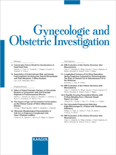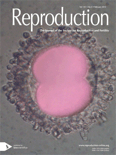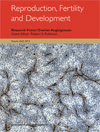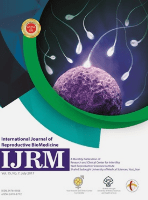
REPRODUCTIVE BIOMEDICINE ONLINE
Scope & Guideline
Shaping the future of reproductive biomedicine with impactful research.
Introduction
Aims and Scopes
- Assisted Reproductive Technologies (ART):
The journal publishes studies on various ART techniques, including IVF, ICSI, and PGT, emphasizing innovative approaches and their clinical outcomes. - Reproductive Endocrinology and Physiology:
Research on hormonal influences, ovarian function, and the physiological mechanisms underlying reproduction, including the impact of various pathologies such as PCOS and endometriosis. - Genetics and Epigenetics in Reproduction:
Exploration of genetic testing, including PGT and the implications of genetic conditions on fertility, embryo development, and reproductive outcomes. - Patient-Centered Fertility Care:
Studies focusing on the psychosocial aspects of infertility, patient experiences, and the integration of supportive care in reproductive medicine. - Health and Environmental Impacts on Reproduction:
Research examining the effects of lifestyle factors, environmental exposures, and health conditions on reproductive health and ART outcomes. - Innovative Technologies in Reproductive Medicine:
Advancements in technology relevant to reproductive health, including AI applications in embryo selection and laboratory practices.
Trending and Emerging
- Impact of Lifestyle and Environment on Fertility:
There is a growing body of research exploring how lifestyle choices, environmental factors, and dietary habits influence reproductive health and ART outcomes. - Artificial Intelligence and Machine Learning in Reproductive Medicine:
The integration of AI and machine learning technologies for embryo selection and prediction models is gaining momentum, marking a significant trend towards data-driven decision-making in ART. - Psychosocial Aspects of Infertility:
Research focusing on the emotional and psychological impacts of infertility and treatment on patients is increasingly recognized as crucial for holistic care. - Endometriosis and Its Systemic Effects:
Emerging studies illustrate the complex relationship between endometriosis and infertility, emphasizing the need for comprehensive approaches to diagnosis and treatment. - Genomic and Epigenomic Research in Reproductive Health:
There is an upward trend in studies investigating the genetic and epigenetic factors affecting fertility, embryo quality, and pregnancy outcomes, reflecting the importance of precision medicine. - Telemedicine Applications in Fertility Care:
The rise of telemedicine, especially following the COVID-19 pandemic, has led to increased research on its effectiveness and patient satisfaction in reproductive health services.
Declining or Waning
- Historical Fertility Treatments:
Research focusing on older methods of fertility treatment, such as traditional ovulation induction protocols, has become less prevalent as more advanced and personalized approaches gain traction. - Basic Laboratory Techniques:
Publications centered on basic laboratory techniques and methodologies may be declining as the field shifts towards more innovative and technology-driven practices. - Single-embryo Transfer Debates:
The extensive debates surrounding single-embryo transfer versus multiple transfers are becoming less frequent as consensus and guidelines solidify around practices favoring single transfers. - Ethical Considerations in ART:
While still important, the frequency of publications specifically addressing ethical debates around ART practices may be declining as regulatory frameworks evolve and become more standardized. - Surgical Interventions for Infertility:
Research focusing on surgical approaches to infertility is waning as non-invasive and less invasive techniques gain preference in clinical settings.
Similar Journals

THERIOGENOLOGY
Pioneering knowledge in veterinary reproduction since 1974.THERIOGENOLOGY is a prestigious academic journal published by Elsevier Science Inc, dedicated to the field of veterinary reproduction and animal science. With an impressive impact factor and recognized as a Q1 journal in various categories including Animal Science and Zoology, Equine, Food Animals, and Small Animals, THERIOGENOLOGY has established itself as a vital resource for researchers, practitioners, and students alike. Founded in 1974, the journal covers a broad spectrum of topics related to reproductive physiology, biotechnology, and the health management of food and companion animals. Although it does not currently offer open access, researchers can benefit from its comprehensive articles and reviews that push the boundaries of knowledge in veterinary science. With a significant placement in the Scopus rankings, ranking #1 in multiple veterinary categories, THERIOGENOLOGY serves as an essential platform for advancing the understanding of reproductive strategies and practices, thereby contributing directly to the fields of animal husbandry and veterinary medicine.

JOURNAL OF REPRODUCTION AND DEVELOPMENT
Fostering innovation in animal sciences.JOURNAL OF REPRODUCTION AND DEVELOPMENT, published by the SOCIETY REPRODUCTION & DEVELOPMENT-SRD in Japan, is a leading peer-reviewed journal dedicated to advancing the field of reproduction and development in animal sciences. With a notable impact factor reflected in its prestigious Q1 Quartile ranking in Animal Science and Zoology, the journal aims to disseminate cutting-edge research that explores the complexities of reproductive biology, developmental processes, and their implications for agriculture and biodiversity. This journal invites contributions that span multidisciplinary interests, thereby facilitating the integration of scientific knowledge and practical applications. Researchers, professionals, and students can benefit from the insights shared within its pages, as it strives to foster collaboration and innovation in the field. The journal’s comprehensive scope and esteemed reputation, underscored by its Scopus rank of #115 out of 490 in the category, make it an invaluable resource for anyone invested in the study of reproduction and development.

Animal Reproduction
Empowering the next generation of reproductive biologists.Animal Reproduction is a premier open-access journal published by the Brazilian Coll Animal Reproduction, focusing on the dynamic field of reproductive biology within both veterinary science and animal husbandry. Established in 2004, the journal has rapidly gained prominence, securing a Q2 ranking in both Animal Science and Zoology as well as veterinary disciplines as of 2023. With a growing impact factor and an engaged readership, Animal Reproduction serves as a vital platform for researchers, professionals, and students seeking to disseminate and gain insights into the latest studies and innovations in animal reproductive health and technology. Based in Brazil, the journal's content spans a wide array of topics essential for advancing the scientific understanding of reproduction in animals, thus contributing to improved practices in veterinary medicine and livestock management. The journal is indexed in major databases such as Scopus, ensuring that the research published is accessible to a global audience. Whether you're a seasoned researcher or a student looking to deepen your knowledge, Animal Reproduction is indispensable for anyone engaged in this critical area of study.

GYNECOLOGIC AND OBSTETRIC INVESTIGATION
Empowering Obstetrics and Gynecology with Insightful InvestigationsGYNECOLOGIC AND OBSTETRIC INVESTIGATION, published by KARGER, is an influential journal dedicated to advancing the fields of obstetrics and gynecology. With an ISSN of 0378-7346 and E-ISSN 1423-002X, this esteemed publication has been disseminating pivotal research since 1895 and continues to serve as an authoritative source through its convergence until 2024. Renowned for its rigorous adherence to academic standards, it stands in the Q2 category for both Obstetrics and Gynecology and Reproductive Medicine as of 2023, reflecting its quality and impact within the scientific community. With Scopus rankings highlighting its commendable positions—Rank #66 in Obstetrics and Gynecology and Rank #31 in Reproductive Medicine—it is an essential resource for researchers, professionals, and students alike, fostering a deeper understanding of women’s health issues and innovative care practices. Despite not being an open-access journal, its contributions significantly influence current and future directions in clinical and translational research.

HUMAN REPRODUCTION UPDATE
Exploring Innovations in Obstetrics and GynecologyHUMAN REPRODUCTION UPDATE, published by Oxford University Press, stands as a leading journal in the fields of Obstetrics and Gynecology and Reproductive Medicine. With an impressive Q1 ranking in both categories according to the 2023 category quartiles and a significant Scopus rank, it is recognized as one of the top journals globally in these disciplines, catering to the most relevant and cutting-edge research. The journal has been a crucial platform for disseminating vital findings and reviews from 1995 to 2024, contributing to advancements in human reproductive health. With its focus on publishing high-quality, peer-reviewed articles, it serves as an essential resource for researchers, healthcare professionals, and students seeking the latest insights and developments in reproductive science. As the journal aims to foster informed discussions and encourage further research, it remains committed to shaping the future of reproductive health and medicine.

REPRODUCTION
Pioneering discoveries in reproductive and developmental biology.REPRODUCTION, published by BIOSCIENTIFICA LTD, stands at the forefront of research in the fields of reproductive and developmental biology. With a focus on advancing our understanding of reproductive health and mechanisms, the journal has garnered an impressive reputation, consistently ranking in the first quartile for key categories including Embryology, Endocrinology, Obstetrics and Gynecology, and Reproductive Medicine in 2023. Notably, it holds an esteemed position in the Scopus rankings, with high percentiles that reflect its significant impact in the scientific community. The journal is committed to open access, promoting the broad dissemination of high-quality research to facilitate innovative discoveries and interdisciplinary collaboration. Situated in the United Kingdom, REPRODUCTION serves as a vital resource for researchers, professionals, and students eager to contribute to the evolving landscape of reproductive sciences and related fields.

REPRODUCTION FERTILITY AND DEVELOPMENT
Innovating the future of reproductive health and biological development.Reproduction, Fertility and Development, published by CSIRO Publishing, is a prestigious journal that has been at the forefront of research in the fields of reproductive science, developmental biology, and related disciplines since its inception in 1989. With an ISSN of 1031-3613 and an E-ISSN of 1448-5990, this journal serves as a vital platform for disseminating innovative findings and methodologies that advance our understanding of reproductive processes and development in a variety of organisms. The journal is indexed in prominent databases, exhibiting a solid standing with a Q3 quartile ranking in both Animal Science and Zoology and Biotechnology, and covering 2023 rankings in multiple related categories. Operating from Australia, Reproduction, Fertility and Development embraces a commitment to enriching scholarly communication and fostering collaborative research efforts. Its focus on high-quality, peer-reviewed articles makes it an essential resource for researchers, professionals, and students seeking to stay abreast of the latest advancements and pivotal discussions in reproductive medicine and developmental biology.

Reproduction and Fertility
Elevating the discourse in reproductive sciences.Reproduction and Fertility is a premier academic journal published by BIOSCIENTIFICA LTD, dedicated to advancing knowledge in the fields of reproductive sciences, obstetrics, gynecology, and related areas. Established with a focus on delivering high-quality research, this journal has quickly ascended in prominence, achieving a commendable Q2 ranking in multiple categories, including Embryology, Obstetrics and Gynecology, Reproductive Medicine, and Urology, as of 2023. With an E-ISSN of 2633-8386, Reproduction and Fertility aims to provide a valuable platform for researchers, professionals, and students alike, offering insights into the latest discoveries and innovations in reproductive health. Although currently not an open-access journal, it remains committed to disseminating important findings that can influence clinical practices and policy-making worldwide. Operating from its headquarters in Bristol, United Kingdom, the journal serves as an essential resource for anyone invested in understanding and improving reproductive health outcomes through rigorous academic research.

Reproductive Biology
Transforming Knowledge into Practice in Reproductive BiologyReproductive Biology is a premier academic journal published by Elsevier, dedicated to advancing the field of reproductive science. With an ISSN of 1642-431X and an E-ISSN of 2300-732X, this journal has been serving the scientific community since its inception in 2001. It notably holds a Q1 ranking in Animal Science and Zoology as of 2023, underscoring its significant impact and prominence in this domain. The journal encompasses a wide array of topics surrounding reproductive biology, including but not limited to endocrinology and developmental processes, making it an essential resource for researchers and practitioners. Although it operates under a traditional access model, its comprehensive scope offers valuable insights that contribute to advancements in reproductive health, animal conservation, and biotechnology. Published in the Netherlands, Reproductive Biology aims to foster interdisciplinary collaboration and innovation, ultimately enriching our understanding of reproductive mechanisms across various species. Researchers, professionals, and students alike will find this journal an indispensable platform for disseminating groundbreaking research and engaging with the latest findings in reproductive science.

International Journal of Reproductive Biomedicine
Pioneering insights in reproductive biomedicine for all.The International Journal of Reproductive Biomedicine, an esteemed publication by SHAHID SADOUGHI UNIVERSITY OF MEDICAL SCIENCES, serves as a pivotal platform in the fields of obstetrics and gynecology as well as reproductive medicine. Established in 2011 and transitioning to an open access model in 2015, this journal facilitates the dissemination of innovative research and critical findings to a global audience, particularly focusing on advancements in reproductive health and biomedicine. With an impact factor reflective of its commitment to high-quality scientific inquiry, the journal has achieved a notable ranking of Q3 in both its categories for 2023, contributing to its growing influence within the academic community. Researchers and professionals benefit from its broad scope, which encompasses a range of topics essential to reproductive health, thus fostering a rich exchange of knowledge. The journal's accessibility allows students and professionals alike to engage with the latest findings and contribute to ongoing discussions within this vital field of study.